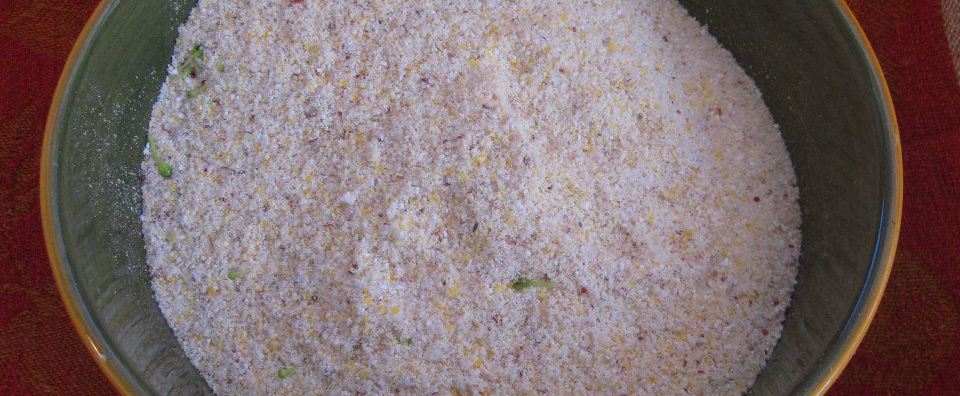I was delighted to see the return of cornmeal in this week’s box. I’ve been dying to make polenta. When we received a bag or two of cornmeal earlier in the season, I spent lots of time making cornbread and corn muffins, and saved cornmeal to use for pan frying all that yummy okra. But I still had cornmeal left over.
One day, thank goodness, the word “polenta” popped into my head, and I did some research. While corn ground specifically for polenta is probably a little coarser than what we’re getting in our little brown bags, I discovered that our cornmeal made delicious polenta, and the polenta was a fabulous base for a number of recipes.
You can serve it freshly cooked as you would use mashed potatoes – a nice base for other savory flavors. If you have leftover polenta, let it cool and it will firm up. Cool the polenta on a rimmed baking sheet, spreading it out to make a thin layer. Once firm, you can cut it into any shape – dredge it in flour and Parmesan and pan sauté it to make little crispy bases for other savory flavors (again).
Our favorite use was to create “lasagna” made with polenta instead of noodles. I layered the pieces of polenta (just cooled, no sautéing) with ricotta, mozzarella, sautéed vegetables and marinara sauce, and then baked it like lasagna. Delicious. And it would work in lots of Mexican-style dishes since it’s similar in flavor to cooked masa harina.
Ingredients:
cornmeal, water, stock
Preparation:
Polenta is just cornmeal cooked in some liquid. It could be water. It could be milk. It could be vegetable or chicken stock.
The basic proportions are something like 1 cup of cornmeal to 4 cups of liquid. But it varies tremendously by what texture you want your polenta to have and the grind of your cornmeal.
Make polenta is just like cooking grits. More liquid, a creamier and softer texture. Start with maybe 3 cups of liquid to cup of cornmeal, and after the cooking is underway, you can add more liquid if it’s needed.
Many traditional recipes for polenta suggest getting the liquid boiling and then stirring in the cornmeal a few grains at a time to help prevent lumps. Not having the patience or interest to stand at the stove for 30 minutes slowly adding cornmeal, I found my polenta was fine if I put my cornmeal in the saucepan and added enough liquid to make a smooth paste. I stirred until everything seemed evenly moist, then added the rest of the liquid.
Let it cook over low heat, stirring occasionally, until the cornmeal is cooked through – which takes maybe 20 minutes? Season to taste – salt, pepper, chiles, butter, cream cheese, garlic – polenta will stand up to the same sort of things you’d use to flavor your grits.
It won’t be long before we start getting fall greens in our box, and polenta with sautéed kale is just another variation of the Southern tradition of cornbread and smothered cabbage. That, with some pan-fried apple slices or maybe some sautéed sweet potato, says “autumn is here” to me.

